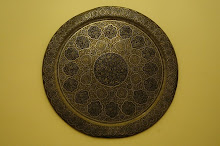
Ibn al-Shatir was an important Arab astronomer who lived during the medieval Islamic period. Like many of his peers he was a polymath and also worked as a mathematician, engineer, artisan, and inventor. He lived in the 14th century, in what is today modern Syria.
Al-Shatir (b. 1304) was orphaned as child and was raised by his grandfather who later turned him over to an uncle who taught him the craft of inlay work, using ivory, wood and mother of pearl - an artform for which Damascus is still famous. When he was old enough, and after having earned a large sum of money, he traveled to Egypt where he studied mathematics and astronomy in Cairo and Alexandria.
From 1360 to 1375 al-Shatir occupied the prestigious position of chief muwaqqit at the Umayyad Mosque in Damascus. He was responsible for the regulation of the astronomically defined times of prayer. He fixed the precise times for the five daily prayers, based on the observations of the movements of the sun, moon and stars. He also had to adjust the Muslim calendar, which was lunar rather than solar.
Al-Shatir also made substantial advances in the design of astronomical instruments. In addition to improving the astrolabe, he constructed in 1371 a magnificent sundial on the northern minaret of the Umayyad Mosque which remained in use until the 19th century.
He also calculated tables (such as the manuscript above), called a zij, for the region of Damascus. These tables enabled one to determine what time it was by observing the height of the sun by day, and the position of a given star by night.
 But his most important contribution was his theory of the movements of the planets. These calculations improved upon the ancient Ptolemaic system and pre-dated the theory of Copernicus a century later.
But his most important contribution was his theory of the movements of the planets. These calculations improved upon the ancient Ptolemaic system and pre-dated the theory of Copernicus a century later. In fact, al-Shatir’s models were mathematically identical to those of Copernicus, which makes it likely that al-Shatir's work was transmitted to Europe and used by the Renaissance astronomer.












